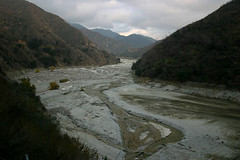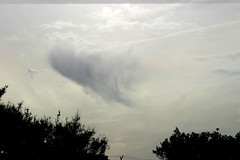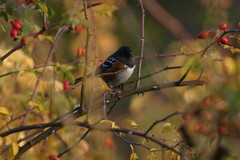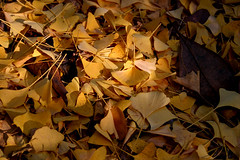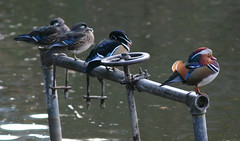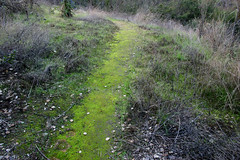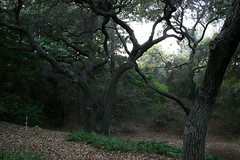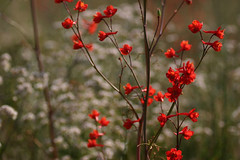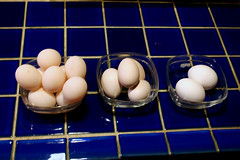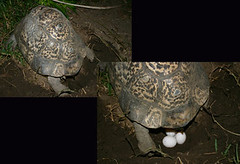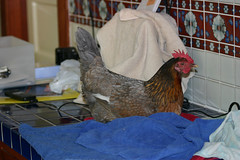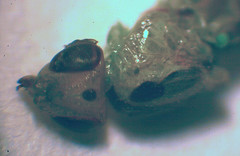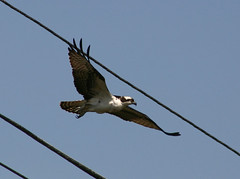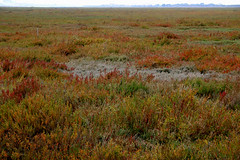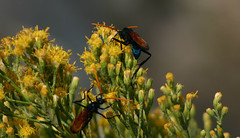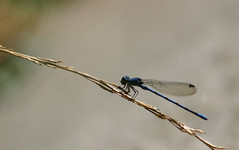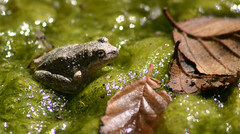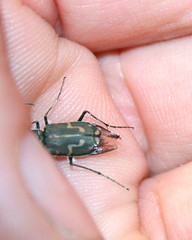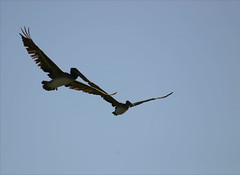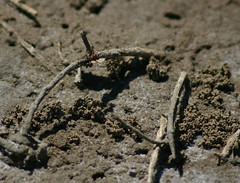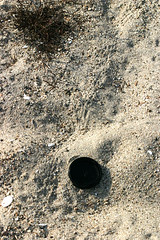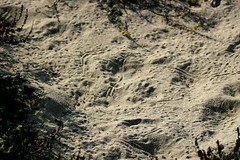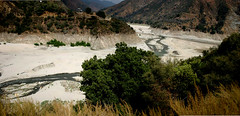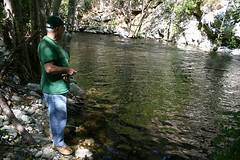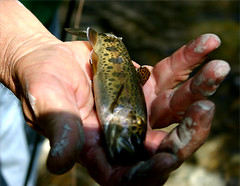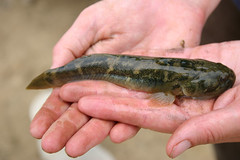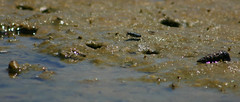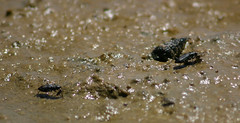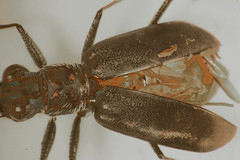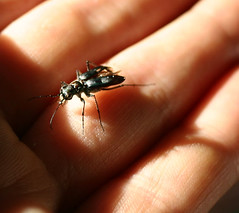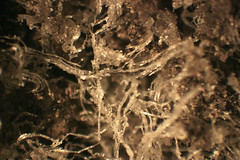Monday, December 26, 2005
Sediment-in-reservoir
It was my birthday today so, I visited the mountains with a friend. What better way to cheer on another year.
The last couple of days the mornings were cool with some fog and then the sun, in early afternoon, would peak out and warm things up. Two days ago it was 87 Fº in Pasadena - nice. I have been planning to go visit the upper watershed and hoped it would stay warm, but alas, the winter clouds won. Still all in all it was lovely.
Water was still pouring in the East tributary of the San Gabriel River. Most of the small waterfalls off the sides of the mountains have been spent. All summer Public Works have been hauling the sediment from the bottom of the reservoir to another location in the mountains to make room for water in the reservoir behind the dam for next year's winter's rains - and to supply water for drought impacted Los Angeles County.
Dams are funny things. We build them to save water and yet they have a limited 'life' span or usefulness. Rivers are a bodies of water which flow from high places to a lower places - they have a much larger body of water beneath the surface in the soils flowing generally in the same direction, albeit slower.The trees and rocks and animals are swept up in the water, too. The flotsam and jetsam that flow on the surface bring minerals to the iron starved oceans and the sediments enrich the effluvial fans surrounding the rivers. The process distributes the plants, animals and water to the surrounding lands, eroding the mountains away. Before people, the washed out trees, brush, and sediments provided protection from predation, material for breeding, and food in the form of islands for the various ocean going organisms.
We build dams. Then rains and snow-melt, which soak through the soils in the mountains, fill the rivers with water. The force of the water washes sediment down the mountain. The sediment fills up the reservoirs behind the dams, which lowers the depth of the man-made lakes. Depending on the amount of rain, and the decomposition of the mountains' soil and rocks, the man-made lakes can, with some bad luck, be filled and useless in ten to twenty years.
I need to visit the new mountain Public Works created from this summer's dredging of sediment....
hanging-cloud
Last Thursday before Christmas the sky was full of these strange clouds. It looked like the clouds wanted to have rain - if you can HAVE rain - but something kept happening to the water droppets. The drops would fall and then get sweeped up back into the air. These silly vapor bags were hanging all over the central vlley of the Los Angeles basin. They somewhat reminded me of a sow's teats.
Sunday, December 18, 2005
Dark-eyed-Junco
Originally uploaded by tardigrade.
Down under in the bushes and roses, this small bird was turning up the leaves on the floor looking for little yummy bits to eat. Perhaps, a ground beetle, or a earwig, or a snail, or a centipede hiding under a twig in the moist soil. All I could hear was the shushing of the leaves below.
Birds are funny little animals. They are curious, and if you make the right noise they will stop what they are doing and come out from hiding to look at where the noise is coming from. Two sparrows were just above the Junko and my walking closer made them fly away. "Chi-Chi! Chi -Chi!" I said and up came this little bird to look.
Down under in the bushes and roses, this small bird was turning up the leaves on the floor looking for little yummy bits to eat. Perhaps, a ground beetle, or a earwig, or a snail, or a centipede hiding under a twig in the moist soil. All I could hear was the shushing of the leaves below.
Birds are funny little animals. They are curious, and if you make the right noise they will stop what they are doing and come out from hiding to look at where the noise is coming from. Two sparrows were just above the Junko and my walking closer made them fly away. "Chi-Chi! Chi -Chi!" I said and up came this little bird to look.
Ginko-leaves
Ginkos, a friend once said, never learned how to be trees - they were too ancient. They grew branches and stems like the lobes on Equisetum, also an ancient plant prior to the Cretaceous Period, sticking straight out perpendicular to the trunk. Oh, but the leaves are so unique and so yellow in fall and early winter here. In China, I have heard people eat the fruit.
Oh , the fruit! They drop to the ground in fall and when crushed, smell like a mixture of dog poo and cheese. However, it is said that they offer good medicine in the form of a vaso-dialator used to help those who forget stuff... Some formulations suggest only using the leaves. Even the yellow jackets that buzz in fall, stay away from the smelly things.... I use them as a deterrent to stepping on my plant beds next to the street. First time steppers in fall are reminded that something was rotten where they last parked...
I'm-so-pretty-oh-so-pretty
Aix gatericulata, Mandarin Duck
Back at Desconso Gardens... the camellias are revving up this winter and many are open. Some are loosing their petals. All are beautiful and delicate..
How is it that SOME males, like this duck, know how pretty they are and need just that special position to show off? Perhaps prance a bit. Bat its eyelashes. Maybe, take a deep sigh just to show how the rest of the world doesn't come up to its standards....
The male Aix sponsa, Wood Duck, isn't someone to sneeze at. He's beautiful. He's willing to sit next to the Mallards.... Anas sp..
Back at Desconso Gardens... the camellias are revving up this winter and many are open. Some are loosing their petals. All are beautiful and delicate..
How is it that SOME males, like this duck, know how pretty they are and need just that special position to show off? Perhaps prance a bit. Bat its eyelashes. Maybe, take a deep sigh just to show how the rest of the world doesn't come up to its standards....
The male Aix sponsa, Wood Duck, isn't someone to sneeze at. He's beautiful. He's willing to sit next to the Mallards.... Anas sp..
Friday, December 02, 2005
green-road
Cicindela no longer run in the San Gabriel Mountains. There are streams and ephemerals that flow all summer long and would be perfect for tigers. When and why they disappeared is not known. Perhaps corralling the streams and rivers into a single flow into a reservoir and the aquifer for the valley below, destroyed their habitats. We will never know.
mysterious-oaks
In a forest of California scrub oaks on a rainy grey day, the dark craggy branches remind me of monster movies with Bella Lagosi or Vincent Price.... Perhaps, Roger Corman comes to mind...? My grandfather worked with Roger and Vincent and Bella ... and even let Ed Wood use his studio on Yucca to do some of his ... eh hem, films. Ed Wood scared my mother (who was a kid) when, for a lark, he took his teeth out to prove his disability from World War II. Peter Lori used to visit at my grandparent's home and was apparently quite a funny man despite his dower appearance. Vincent Price was an art collector and loved my grandfather's work. It is too bad I wasn't there to enjoy the ghoulish crowd.
Tuesday, November 22, 2005
so-red
How can it be? It's winter! Damn! I miss the smell of flowers and the buzz of the bugs.
Birds still visit my yard - mostly sparrows and finches. I tried to entice a scrub jay to come down from his tree with a carrot - but he thought I was nuts.... "What do you mean a carrot. I want a peanut!"
California has seasons just not as dramatic as having snow. In the San Gabriel Valley you can watch snow come and go with the rain... it rains down here and the snow drapes on the mountain. I love and miss the flowers...
The Gingko tree is bright yellow and that's wonderful. I sweep the leaves and sprinkle them about the front of my yard between the bushes. The contrasting yellow on the ground is beautiful. I hate throwing away leaves. It is still not cold enough to have killed off the frantic yellow jackets.... they are a nuisance.
The crickets are still singing here and there. I miss them at night in winter. I have some of this wonderful red Delphinium cardinale - a member of the Ranunculaceae family. They are six feet tall and love the dry weather of California. My blue Delphinia continued to bloom until last week...
The best thing about winter are the cool nights..... the short days, the lack of crickets, the few birds, the grey skies.... nah!
Sunday, November 13, 2005
eggs
Ernestine, the leopard tortoise had another batch of eggs...
Ernestine's eggs from last night are on the left. Miss Chicken's are in the middle. And the right two eggs are from the market and they are Large Grade AA.
It is cool outside right now at night. The sun makes the day warm and the tortoises bask. But, last night Ernestine broke through her cage and started digging a hole with her back feet to deposit her eggs.
Ernestine had found a spot of just dirt and she started to dig in it with her long back claws. The soil is dry so she urinated in it to make the soil easy to dig. Ernestine has a huge capacity so the area was as wet as if I had poured a quart of water at her rear.
For three hours she dug and finally she put her head in and pushed hard. Her tail wagged and a clear mucus dripped and then her first egg appeared. It seemed as if this was not only a Herculean effort, but a painful one at that. The egg dropped slowly into the wet soil of the six by 12 inch hole. Each egg was wrapped in this clear mucus that allowed the egg to touch down slowly on the others without a sound. The egg shells are similar to chicken eggs except when the mucus is removed they are more porous.
After the ninth egg she was so tired. She tried to close up the hole but it was around 52 degrees F outside at 10 p.m. and so I decided to bring her inside. I put her in the sink and filled it with warm water. Her eyes were sunken from dehydration and I hoped she would drink as she normally would do. She kept moving her legs as if she was still outside trying to fill the hole with her eggs.
Ernestine does not have a mate and so her eggs are sterile. In the same way as Miss Chicken lays sterile eggs because she, too, does not have a mate. Miss Chicken has several 'times' a year when she is ready to lay eggs. Her personality changes and she does this little dance when I come close to her - I suppose she sees me as her 'mate.' Miss Chicken 'chucks' at the kitchen door to be let in and then finds her spot. She will spend approximately an hour laying her one egg. Ernestine, on the other hand lays many eggs all at once.
Inside Ernestine's egg is very much like Miss Chicken's egg. There is a white and a yolk. Some people like to eat turtle eggs.... like those who like chicken eggs. Sometimes it is hard for me to eat one of Miss Chicken's.... I don't think I can eat Ernestine's..... I will stick to tomatoes and almonds and other plant materials ....
Ernestine's eggs from last night are on the left. Miss Chicken's are in the middle. And the right two eggs are from the market and they are Large Grade AA.
It is cool outside right now at night. The sun makes the day warm and the tortoises bask. But, last night Ernestine broke through her cage and started digging a hole with her back feet to deposit her eggs.
Ernestine had found a spot of just dirt and she started to dig in it with her long back claws. The soil is dry so she urinated in it to make the soil easy to dig. Ernestine has a huge capacity so the area was as wet as if I had poured a quart of water at her rear.
For three hours she dug and finally she put her head in and pushed hard. Her tail wagged and a clear mucus dripped and then her first egg appeared. It seemed as if this was not only a Herculean effort, but a painful one at that. The egg dropped slowly into the wet soil of the six by 12 inch hole. Each egg was wrapped in this clear mucus that allowed the egg to touch down slowly on the others without a sound. The egg shells are similar to chicken eggs except when the mucus is removed they are more porous.
After the ninth egg she was so tired. She tried to close up the hole but it was around 52 degrees F outside at 10 p.m. and so I decided to bring her inside. I put her in the sink and filled it with warm water. Her eyes were sunken from dehydration and I hoped she would drink as she normally would do. She kept moving her legs as if she was still outside trying to fill the hole with her eggs.
Ernestine does not have a mate and so her eggs are sterile. In the same way as Miss Chicken lays sterile eggs because she, too, does not have a mate. Miss Chicken has several 'times' a year when she is ready to lay eggs. Her personality changes and she does this little dance when I come close to her - I suppose she sees me as her 'mate.' Miss Chicken 'chucks' at the kitchen door to be let in and then finds her spot. She will spend approximately an hour laying her one egg. Ernestine, on the other hand lays many eggs all at once.
Inside Ernestine's egg is very much like Miss Chicken's egg. There is a white and a yolk. Some people like to eat turtle eggs.... like those who like chicken eggs. Sometimes it is hard for me to eat one of Miss Chicken's.... I don't think I can eat Ernestine's..... I will stick to tomatoes and almonds and other plant materials ....
Ernestine
Ah, poor Ernestine. I have looked after her since 1987 when she was the size of a grapefruit. I think that leopard tortoises, Geochelone pardalis, are so beautiful. I bought Ernestine from a pet store whose owner adored tortoises, too. She introduced me to her vet who to this day still comes to look after the menagerie.
Ernestine in action... HERE
Leopard tortoises need to be warm in the sunlight and have access to water - they love to sit in both. When I moved to Ohio these requirements were difficult to adhere to but the house in Ohio had old fashioned radiators under the kitchen sinks. So, I would keep Ernestine in a black plastic cement mixing container on the counter. She also had a light to increase her exposure beyond what we had in the more northern latitude.... and so Ernestine grew.... and grew.
One fateful day, Ernestine now a full 18 inches long and almost 20 pounds, felt she needed to get out of her confinement.
My young daughter and a friend sleep beneath over in the basement in a room for guests beneath the kitchen. In the dark of morning they heard what they thought to be rain falling but, instead they awoke to find the ceiling tiles floating in a foot of water in the basement. They got up in a panic to find water coming down the walls and the stairs ..... Up they rushed to find Ernestine had slipped out of her cement mixing bucket and into the kitchen sink. She had tried to get out of the sink and had turned the hot water on her self. By the time we all saw the deluge, the water was cold... but Ernestine had burned herself quite badly.
The vet in Ohio had me give Ernestine anti-bacterial injections because her neck, her front legs, and her back legs were swollen and smelled of infection. Flies started to infest under her shell but one of the other smaller tortoises kept an eye on the maggots and followed Ernestine about for small snacks. Eventually, Ernestine healed but the scutes on her upper carapace fell off.
How big do leopards tortoises grow? Well, in 1993 I traveled to South Africa, where these reptiles are from. I was standing next to my hosts near an open field near the back brush. Down below in a clearing I spotted something about 3/4 mile away that looked very familiar. I yelled. "it's a tortoise!" and ran down the hill with a small crowd behind me not understanding my glee. I found a small coffee table sized female leopard tortoise which, could have weighed over a hundred pounds.... and out from the bushes around her were four or five males - around 25 to 30 pounds. I brushed her back and found a few ticks the size of the end of my thumb attached to the soft part of her carapace between the scutes. She never flinched as I touched her. Wonderful!
Saturday, November 05, 2005
Ephydridae and Chalcididae

Looking at sticky trap after sticky trap full of so many insects I get very 'antsy'.... sorry.... Funny thing, the 280 8x8 inch sided sticky traps are different from the 280 sticky traps from last year and the year before and the year before that.... What is the difference? Well, this spring had a large storm event that took out a large portion of the Mugu Lagoon habitat. It probably caused changes in the upper watershed that flows into Mugu. There are different genera and families this year. There are many more individuals as well.
Why would something so devastating like the spring 2005 storm event cause so much change? ~ More families, more species more numbers???? Also, there seems to be more parasitoids and hyperparasitoids. This Chalcid wasp (on the right) seems to be stuck on traps in large numbers with even larger numbers of Phoridae.... Are Phoridae parasitized by Chalcids??? (The fly on the left is an Ephydridae a very salt tolerant Diptera)
Sticky traps are like trying to understand ecology in the La Brea Tar Pit style.... When 'A' falls in and gets trapped in the tar pit (sticky trap), it may have been chased by 'B' which, when stuck is attacked and killed by 'C' which is then eaten by 'D'... The difference between digging bones out of the tar pits and identifying insects mushed on sticky traps are different exercises.... oh my aching eyes...
Please note that the larger fly is only 2 mm .... and that there are wasps a quarter the size of this particular Chalcid!!!!
Sunday, October 23, 2005
Chicken
What does Miss Chicken know about impending doom?
In the morning she is happy to see me and chortles with delight as I take her from her cage to the tool shed where I keep her corn. I take a handful and sprinkle it on the ground at the entrance to the back door. She has a special vocalization that she makes when she has found something very delicious like a worm or spider ... or her morning breakfast. The cats walk carefully around her and she watches them closely, too. Sometimes she likes to take a few mouthfuls of their dry food.
I let her roam the backyard for tiny insects. Slugs, which she grabs with deftness, throws it back into her gullet. Happy chicken. Sometimes I buy meal worms for her as treats. The happy sounds that she makes. If she is across the yard and sees me with one in my hand, she will run with her grey skirts flying to snatch the writhing larvae from my fingers.
Sometimes she gets lonesome and calls for me. She used to have a friend but she died several years ago from a heart attack. Miss Chicken hid in the bushes for days. She makes a different call to me when a hawk comes to check her out. or if stray cats come to hunt for birds. When the hawk alights on the fence she yells 'chuck chuck squawk!' If I come home too late at night and she is not at the backdoor for some reason, I hunt for her in the trees.
One night I could not find her. I looked everywhere with a flashlight. I am sure the neighbors think I am crazy. I went to bed sad knowing the raccoons sneak in my yard to hunt for fish in the pond or.... Then in a terrible squawk, with a deep throated clucking she screamed for help. The dark night made it hard for her to see. I jumped from my bed and ran out the side door to find miss chicken had gotten away once again from the jaws of the raccoons. She sat under the light outside and I picked her up. She was quiet when I put her in her cage.
So from where did this terrible H5N1 come from? I know the people in China do not think about their birds like I do - but perhaps some may. One virus or up to ten of them can cause her to be very sick and she would have less then half a chance to live. I carry her about and give her a kiss on her head, so I, too, could become sick from this disease. Where would it come from?
Doves like to clean up her corn that she does not finish. Could they carry it? At night I hear geese flying could they drop it in my yard somewhere in their excrement? Could the raccoons carry it to my yard? or the squirrels? I am in the pathway of the green parrots - could they bring it to us all?
I bought her for five dollars from a ranch not too far away from my house. I found an ad in the throw away papers. I miss not having a chicken in my backyard. She was an adult bird and sat on other birds eggs she is a brooder. She is and has always been a very personable bird and loves to follow Eddie my gardener about when he digs or trims or sweeps.... When she laid eggs, she is now past that time in her life.... she preferred the kitchen counter. To inspire her, I would put my iPod in the towel next to her. She would pull the iPod by dragging it with her 'chin' under her feathers. She would sit on the iPod until her body was ready to expel her egg.
I don't see myself not caring for this animal. What to do....
Wednesday, October 19, 2005
new secretary
Monday, October 17, 2005
Meromyza sp
This is a mangled specimen. I have been identifying insects caught on sticky traps for Mugu and the Institute of the Environment and this poor devil was a mess. Also, I have never come across this animal at Mugu on sticky traps nor sweep nets nor Malaise traps. I was stumped!! So, I asked a wonderful entomologist friend to help me out and he said it was in the family of Chloropidae.
Chloropidae. It is one of the very few I have ever seen at Mugu with so very little coloring in its exoskeleton. The haltare was turquoise simply because of the thickness of it tissues. The face was triangular, and it seemed to have a eyespot on its 'forehead.' The femur of its back leg was thick and it had stripes on the dorsal side of its thorax.
One website from Cedarcreek said it was a grass fly that liked to buzz around eyes and wounds. Another said it liked aphids. The three specimens I found on sticky traps were peppered with aphids. In fact, there were more aphids then thirps this season. And, there were more parasitic wasps then from other years.
Could have the storm events of last spring changed the configuration and abundances in the Mugu insects?
Here is a much better picture of this Meromyza sp..
http://cedarcreek.umn.edu/insects/album/029094050ap.html
I have been counting and sorting insect traps and worms from core samples of the soils from Mugu. This is the hard part. Collecting is the easy part. I love collecting and walking and finding new animals.....
Monday, October 03, 2005
Last day at Mugu

My friend and I went to Mugu on Friday, September 30. Beautiful day! But, it was our last day. So very sad. I suppose that the Navy is tired of biologists counting and assessing the plants and animals. Or maybe they are tired of scientists who watch the environment. Or could it be it is not the Navy who does not want us, but those who direct the Navy and other military bases which have the highest number of endangered organisms in the country. Perhaps, with what they do for a living - what they stand for, they hate the idea they must be stewards of important plants and animals.
My friend took this picture of me as I was looking at the different holes in the ground and walking with my net and camera. There were terrible fires in Chatsworth and Ventura the last few days. Ash was falling and drifting all over for many miles. Some of the solitary bees' holes had been usurped by spiders. Maybe, the bees were hiding deep into the ground while the spiders were borrowing the upper chambers because, there were little webs covering the holes festooned with ash.
Sunday, October 02, 2005
flying-osprey
Sitting on the electrical wire was an osprey which was watching the fish swim in the creek. My friend took this picture as I stepped out of my car.
fall--at-Mugu
The Salicornia sp. changes colors in the fall. Sometimes with orange-reds sometimes with magentas. This patch of grey-blue is a dead patch caused by a fungus.
Tiger hunting

My friend is a fine hunter of tigers.
The first step in hunting these wonderful animals is to spot them as they stand tall on their long graceful legs like slim twigs on the hot salted soils. Then, you must walk carefully - not letting your shadow cross over them because they will either disappear into the background or fly into the brush. Crouch low with your net out in front and holding the netting with your other hand... in a quiet moment wait for the tiger to clean itself.... then BLAM! Into the net. The tiger struggles in the netting. Its metallic carapace glistens in the sun. It tries to fly and then tries to find an open or torn spot in the net... You wrap the net around the struggling animal. You take the fierce tiger in your finger tips as it gnashes and slashes at you with its sharp mandibles. Such fantastic creatures!
Tuesday, September 27, 2005
Checker White butterfly

This little Checkered White (Pontia protodice), usually found away from urban areas, was flitting about the San Gabriel River in the North Fork. There is a wonderful ephemeral pool where I have found a nice population of California Tree frogs (post September 3) and this one butterfly was very busy. I took this picture just as it was landing. You can see it was unwinding its proboscis in anticipation of the nectar in the flower.
Mountain Sky

At 5:30 on Monday, September 26, the San Gabriels looked as if the ocean of air would boil into a rain storm. You could see deep shapes in the clouds as the tips of the mountains caused the air to flow like water. Below, the wind rippled the water in the reservoir.
After I collected my traps the sky was clear at 6 p.m.
Mayfly

Ephemeroptera, as adults, do not feed but must within hours of emerging, find a mate before they must die. Mayflies are strong indicators of water quality because they need high amounts of oxygen which they take from the water. Animals that breath through the water are more susceptible to heavy metals, and other anthropogenic toxins. Stoneflies, riffle beetles, water pennies, dobsonflies, and caddisflies also are pollution intolerant, and if the body of water is dominated by these animals the water quality is good.
Dragonflies, crane flies, crayfish, dragonflies, clams, crustacea, and beetle larvae can tolerate a much broader range of water quality. However, if the water body has aquatic worms, midge larvae, black fly larvae, pouch snails, leeches and mosquitoes dominating, then the water quality is poor.
This mayfly (and others) were flying above the San Gabriel River at 6 p.m. September 26 the temperature was 81 degrees F. It liked the hood of my car.
Saturday, September 17, 2005
tarantual-hawk
Pompiliidae, Pepsis sp. is one of the largest wasps in the world and has one of the most powerful stings. I kept one in an aquaria for a few months. She was about 4.5 cm long and was as beautiful as these - though, this photo does not do these animals justice.
As adults, they are nectar feeders but as larvae, they consume a still live but paralyzed spider that was provided for them by their mother. They are very expressive animals in that you can tell their temperament by their body language. When excited, they walk jerkily and tap their wings. When calm but excited, they stretch out their antenna. When angry, they point their antenna towards the offending animal and curl and uncurl them. When totally calm the antenna is curled and slightly drooped.
The wasp that I took care of, at first attempted to attack me by flying at my face. In the morning, I would walk into the kitchen and she would pace back and forth with angry movements. I offered her 'cat food juice' and sugar water. I would open the lid very carefully so I could insert a syringe to squirt some sugar water into a small dish. Eventually, she did not display 'anger' when I entered the kitchen, but excitement as in the photograph. Later, she would take the syringe in her front legs and drink from the tip with her antenna curled and drooping.
These animals can never become 'tame' as we might think of some snakes or turtles, but I found my Pepis to be very smart and aware. She knew when I was coming to feed her.
Thursday, September 08, 2005
It's the Holiday ... let's get stupid!!!
After

After all of the people left the Mountains on Monday from the long Labor Day Weekend... they left their garbage behind. The Forrest Service men and women end up being housekeepers and trash collectors. Diapers are probably the most disgusting thing - beside the toilet paper all around- I can think of that they throw about. I image these people defecating anywhere from the distribution of their trash. And, just above the river are two port-potties... nasty!
Monday, September 05, 2005
dragonfly
Flame Skimmers (Libellula saturata) have been visiting my pond for many years. Like all dragon flies, in repose. their wings are set to the side. The males are bright red and the females are light red-brown.
I have observed very violent mating rituals in this species. The males will perch on a tall stick waiting - not for what I thought, prey...
Then from above, females spotting the males, dive, grab and essentially rape them. The males are then thrown aside in a daze. While the males buzz erratically about the pond for a moment, the females bounce above the water's surface shooting their now fertilized eggs into the pond water.
I have observed very violent mating rituals in this species. The males will perch on a tall stick waiting - not for what I thought, prey...
Then from above, females spotting the males, dive, grab and essentially rape them. The males are then thrown aside in a daze. While the males buzz erratically about the pond for a moment, the females bounce above the water's surface shooting their now fertilized eggs into the pond water.
Sunday, September 04, 2005
Damsel
The Vivid Dancer (Argia vivda) is in the Damselfly family, Coenagrionidae. The females are brownish but, on occasion will take on blueish tones. The 'dancers' (genus Argia) hold their wings above their abdomen whereas bluetets (a similar looking damselfly in the genus Coenagrion) hold their wings in repose by their abdomen.
Beautiful-frog
A California Tree frog (Pseudacris cadaverina) sat in an ephemeral pond in the North Fork of the San Gabriel River. The midday sun was about 93 degrees F. and has been quite hot all summer.It is not only a special moment to find this frog sunning itself on top of the angel hair moss, but it is a wonder why this pond still has water in it and it's September 3!
Monday, August 29, 2005
Mugu-upper-marsh
The upper marsh gives one the impression of being alone. The silence is beautiful. The bees quietly buzz 10 centimeters above around the ground. There is so much to learn up here. Water seeps from the hills during the rains and salt water squeezes through the sands from the ocean. I find new animals all the time. Shrews, six types of dragon flies, tiny velvet ants....
Deformed-C-s.f.
This is the second deformed Cicindela I have found at Mugu. The first one was Cicindela hemorrhagica this one is Cicindela senilis frosti.
Could they have become deformed because of the stress of the storms from last winter? or from water causing objects to deform their pupal cell? or could be it because of some substance in the pore water?
These two beetles were smaller then normal which usually indicates poor nutrition... what could have happened? Could they have had conditions so stressful during their larval stage to force them into complete metamorphosis before proper development?
The numbers of deformed wild insects are usually much smaller then the commercially grown insects like meal worms or crickets. I am surprised to find living tigers with such deformities! They were so easy for me to catch them... a bird would have had them for a small snack.
Pelis-at-Mugu
Brown pelicans float on the wind above the water looking for tasty bits just near the surface of the water.
When they see something... they fold their wings, face downward, and dive.
Gosh! To be able to do that!
Otitidea-in-tiger-burrows
Dancing about the upper marsh is a fly - an Otitidae fly that lays its eggs in the burrows... Whose burrows? Well, there are Halicitidae bees and Cicindela beetles....
It struts and flips its wings, it scurries sideways and drops out of sight into a hole of .... which insect? perhaps both????
Can you find the fly with the pointed face?
Wednesday, August 24, 2005
Malaise trap in the forest

The Malaise trap is set up in the forest of the San Gabriel Mountains. This is the West Fork site about 1 and 2/10 mile from the locked gate. The trap is about five meters from the River water's edge. So far, moths, flies, spiders, grasshoppers, mosquitoes, midges, wasps, and black flies have found their way up into the head of the trap. I will collect one more sample from this area before I move it to the next site in the North Fork.
The drop traps in the area are collecting ants, wasps, beetles, flies, an occational baby lizzard, moths and lots of spiders.
What could be the differences between the Ventura Marsh at Mugu and the Riparian brush in the Mountians?
Sunday, August 14, 2005
who's-that-footprint
I found this trail in the sand dunes near the firing range of Mugu. I know who made his trail. Do you? I threw my lens cap on the sand to show the size of the animal. Here are some hints: it's not a vertebrate, it walks side ways, and some people make ____cakes out of them (although, I doubt this species).
Can you count the number of animals in the next picture? there are three mammals and one reptile.
Can you count the number of animals in the next picture? there are three mammals and one reptile.
footprint-2
Many many animals live in the dunes of Mugu. Sand dunes and the beaches next to them have 'wrack' thrown up on to them from storms. The plants adapted to the sand, heat and salty water create a netting to hold the sand and they are homes to these vertebrates and invertebrates. Sometimes the only way to know who lives here is to look for 'scat,' bones, burrows, and footprints.
Way too many people

At the base of the West Fork of the San Gabriel River, many people gather to swim, and pick-nic. My son asked if they knew that they would be drinking that water.... I doubt that that crosses their minds.
They aslo bring charcol and make small fires to cook their hamburgers. Sometimes, they do this under a tree. I guess to get out of the sun, but I doubt that they think about the fire escaping into the very dry brush all around them....
In an earlier post I took a picture of a roll of toilet paper next to the river left by pick-nicers. They also leave tons of diapers.
Wednesday, August 10, 2005
Dry-San-Gabriel-bed
After tons of silt and sand were scraped from the bottom of the River behind the Morris Dam (up-stream of the San Gabriel Dam), many more tons will have to be moved.
Good-fishin-hole
Chuck, from the Fisheries Resource Volunteer Corps, has taken on the task of looking after a part of the San Gabriel River. He helps keeps the area free of trash from visitors, conducts classes in the proper etiquette in Forest use, and helps other groups enjoy this resource. This is one of his favorite fishing spots, "Fishing is really all about calories" said Chuck, " Fish have to find a spot where they can hold still and still eat ... other wise they can starve, ware themselves out, or both... Fish hang out in areas where the fast moving water and the still water come together... If you were a gold miner that's where the gold would be, too."
wild-trout
These trout were stocked in the San Gabriel River a hundred years ago. In this part of the River you can only catch and release. The pattern of spots on this fish is beautiful! As the fish gets older and bigger, the tanins in the water darken the fish.
Mugu morning and the Malaise traps

Tuesday, the drop traps were emptied and three Malaise traps were set around the parameter of the two IOE sites. The traps are circled and you can see from the size of the center trap by comparing it to the Hummer, which is about eight meters away.
The mist was still hanging above the mountains that morning. Birds were in small flocks here and there. The sound of the waves were behind me. There were a few damsel flies I had not seen before. flitting about. Tomorrow, I will bring my net and see if I can catch and identify them.
This is why I love Mugu.
Sunday, August 07, 2005
Mugu-fish
This is long-jawed mudsucker (Gillichthys mirabilis). This little guy was caught in the crab trap set to catch crabs. It is baited with dry dog food which sometimes entices intrepid mice. ~ The mice have to dodge birds, rattle snakes, in-coming tides, lots of mud, and large distances from dry land where they make their homes.
We catch, measure, and release animals. This mudsucker got to have its picture taken.
Beautiful!
We catch, measure, and release animals. This mudsucker got to have its picture taken.
Beautiful!
California marsh plant community

The Atriplex has been seen more in the mudflats and marsh recently. -It is salt tolerant. The Salicornia is in bloom and so is the Frankenia. Frankenia has beautiful pinky purple flowers that the various bees and bee flies come to feed. Salicornia flowers are small yellow/white and emerge from the 'folds and creases' of the globular plant.
Salicornia can be nibbled. I first ate it in a salad in Canada harvested from the Queen Charlotte Islands. I don't recommend eating it where municipalities (like Ventura or Los Angeles or anywhere near a city in the upper watershed) dump their road run-off because, it can take up metals and other anthropogenic chemicals. But, I can tell you it is salty like a pickle.
Here is a spot in the marsh where many plants live together - in one meter square.
Who's that tiger?
Wednesday, August 03, 2005
How do you tell the difference...

I think the joke goes as follows, 'How do you tell the difference between a black bear and a brown (grizzly) bear? Answer: When you climb up the tree the black bear will follow you and the grizzly will just push the tree down.' In other words, you are toast! or just petit fors.
This is a black bear in the San Gabriel Mountains. One of the contracted workers who is re-building roads washed out from the spring rains, watched this bear walk down the road in the bike lane (are bikers tasty?) and then turn into the day camp grounds where families enjoy weekend lunches.
Bears and camp grounds

Bears should be in the woods. Bears are not pets. Bears, even 'little' black ones, can eat you. It is always prudent to expect predators to look at you as food.
It is too bad that people are not careful about leaving a trail of trash where ever they go.... The rule of thumb is; people go as far into the woods as a man can carry a cooler of beer... (This is a funny image. And oddly enough holds true for parks and forests near cities.... I did not make this up on my own... this is from someone who works in the Forrest and has observed many people in the woods...). The unfortunate thing about many forests is that people leave tons of trash in areas where people like to go... which encourages hungry bears to visit, too. It is kind of like people set traps for themselves.
Saturday, July 30, 2005
C.h.h.-at-water-edge
A enclave of C.h.hemorrhagica has developed in an area that had none that I could find in 2003. There are probably over a hundred in an area of 1 meter by 18 meters. They are sharing this space with about 50 sand wasps (Bembix comata). These tigers like to go to the water's edge and catch the little bugs and flies that run near on the muddy salty water.
false-color-Hemorrhagica
This is Cicindela hemorrhagica hemorrhagica. He is very small for his species. This false color image shows that he not only has torn connections to his left outer wing, which causes it to stick out, but he also has damage to the right side of his elytra and flight wings. If you look to the top outer wing covering, there is a gash. This is a typical 'cut' from a tiger beetle. Many times tigers flip their prey over and make a slice in their abdomen. If the insect (or other arthropod) is a strong fighter then the tiger may go for what ever is available.
I found this tiger yesterday running near a spot where tigers were not reported. He was in an area where leaf cutter bees were stocking their individual hives (holes in the ground) in the sand. This tiger had been in a fight - most probably with a larger more aggressive tiger and could not fly. I caught him with my hand and put him in a glassine bag - as I always do. In a short time, I noticed a tiger with a red abdomen running under my feet... Some how this little spunky guy wiggled his way out of his container jumped out of my breast pocket and was trying to get away through the salicornia.
His red abdomen gave him away. He bit me through out his confrontation. What a great little fighter he is!
I found this tiger yesterday running near a spot where tigers were not reported. He was in an area where leaf cutter bees were stocking their individual hives (holes in the ground) in the sand. This tiger had been in a fight - most probably with a larger more aggressive tiger and could not fly. I caught him with my hand and put him in a glassine bag - as I always do. In a short time, I noticed a tiger with a red abdomen running under my feet... Some how this little spunky guy wiggled his way out of his container jumped out of my breast pocket and was trying to get away through the salicornia.
His red abdomen gave him away. He bit me through out his confrontation. What a great little fighter he is!
Hemorrhagica-hand
Here is what C.h.hemorrhagica real color looks like. He is calmer now, and has eaten some cat food and bit the soil in his aquaria for water. This specimen has no markings on his elytra and is a stealy black. Beautiful!
Friday, July 29, 2005
Cicindela trifasciata sigmoidea

In 2003 I hunted for tigers all around Mugu. I only found a few of these beauties. They were wonderful and as mated couples (in the aquaria), they shared food (kills). Today, I found many many of them on the mudflats and in areas I found without any tigers in 2003 . There were also many many larvae burrows, too. I was concerned for their population because of the heavy rains this last winter. But, it seems they are doing well and so are their favorite food - beach bugs and sand flies.
Two of these golden beauties were brought home and fed cat food and house flies.
YUM!
Tuesday, July 26, 2005
salt-crystals
If the silty soils of Mugu estuary are let to dry, a tangle of salt crystals grow between the matrix of the grains and particles and excrude super fine hairs. The sharp but flexable needles criss-cross throughout the drying mud.
This photo shows salt crystals and grains of soil (they are the dark areas completely surrounded by the salt) amplified 20x under a disecting microscope.
This photo shows salt crystals and grains of soil (they are the dark areas completely surrounded by the salt) amplified 20x under a disecting microscope.
Subscribe to:
Posts (Atom)
